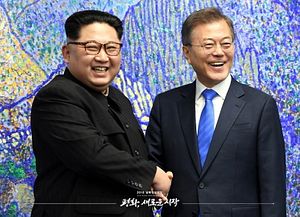Since assuming office in May 2017, South Korean President Moon Jae-in is proving to be nothing short of a visionary. But the flurry of summitry surrounding North Korea’s nuclear program since the 2018 Winter Olympics in PyeongChang has overshadowed an equally ambitious plan that has been brewing in the Blue House for building toward peaceful reunification of the two Koreas.
Moon’s proposition is a simple, yet potentially transformative one: create a railway system that connects South Korea and North Korea to Russia, China, and Europe. The goal is not simply to alter Pyongyang’s strategic calculations with regard to its still-active nuclear and related weapons programs but to turn the Korean Peninsula into a new growth engine for Northeast Asia. This could fundamentally alter the Northeast Asian regional balance of power, positioning North Korea as a critical node that connects East Asia to Eastern and Central Europe.
Moon’s economic plan is not without precedent. Previous South Korean presidents, including Kim Dae-jung with his original Sunshine Policy, envisioned a phased process toward reunification that included economic and rail links between the Koreas. The 1994 Agreed Framework between the United States and North Korea sought to provide Pyongyang a measure of energy security, first through the provision of heavy fuel oil, then through two light-water nuclear reactors. And Russian governments have, for the past decade, called for completing gas pipeline projects that run through North Korea and connecting rail transit across the Eurasian continent.
But the historic Trump-Kim summit in Singapore breathed new life into Moon’s so-called “New Economic Map of the Korean Peninsula,” which he most recently showcased at the 42nd annual Singapore Lecture in July. The two most striking features of this new regional connectivity vision focus on energy and overland transportation. Specifically, Moon envisions the construction of a trans-Korean gas pipeline that would bring Russian gas through North Korea down to South Korea’s industrial hubs, as well as a railway system to link Seoul to Kaesong, Pyongyang, Nampo, and Sinuiju in North Korea — and on to Dandong and Beijing in China. From Beijing, the Trans-Mongolian and Trans-Siberian railways could then make it possible to transport overland freight from South Korea’s southernmost coastal cities all the way to Europe.
South Korea’s newfound diplomatic activism has perhaps in part been spurred on by doubts about the durability of a regional order premised on active U.S. engagement, as well as the necessity of balancing between the United States and China. Today, while a still-nuclear North Korea necessitates that Seoul work to maintain U.S.-South Korean security cooperation, it must also take Beijing’s interests into account as its trade-dependent economy is still deeply tied to Chinese markets. Locked in this precarious geopolitical balancing act between China and the United States, South Korean leaders are simultaneously looking north, south, and west in a bid to diversify economic partnerships and mitigate risk.
The Moon administration’s New Economic Map is potentially a savvy, but fundamentally risky, proposition — a direct appeal to the interests of North Korea, China, and Russia, all major regional stakeholders who have a vested interest in seeing stability on the Korean Peninsula. Beyond questions of commercial viability, the initiative hinges on progress in ongoing U.S. negotiations with North Korea over its nuclear program.
South Korea’s larger neighbors will also respond with their own ambitions in mind. Beijing will inevitably bring Seoul’s New Economic Map into the fold of its Belt and Road Initiative (BRI). South Korea is in the top tier of China’s hierarchical neighborhood diplomacy, which privileges key neighbors willing to accept Beijing’s entreaties. And though Beijing couches the BRI as a benign instrument for advancing a power-neutral concept of “connectivity,” it has specific benefits in mind. An inter-Korean railway that connects Seoul to China’s northeastern provinces via Pyongyang essentially grants Beijing a low-cost eastward extension of its massive infrastructure initiative, creating an overland connection between major South Korean and Chinese industrial hubs.
As South Korea opts for flexible economic partnerships, such as with Russia, where specific interests overlap, the implications for the United States’ role in Northeast Asia may be profound. While the Eurasian continent looks to be more connected than ever before, the United States is increasingly seen as retreating from the front. Countries such as Japan, South Korea, and India once took the backseat to U.S.-led initiatives, but these very same middle powers are now moving quickly, fashioning themselves into an array of multilateral arrangements to fill the void of American leadership. U.S. allies’ decisions, both in Europe and Asia, to join the Asian Infrastructure Investment Bank in 2015 in spite of its objections are one example of the types of frictions that could become more common in the future.
Absent a decisive American strategy and clear and consistent messaging, key partners and allies like South Korea that have traditionally looked to the United States for leadership will begin to hedge their bets. These maneuvers, left untended, will jeopardize the United States’ historic strategic influence in Northeast Asia.
Dr. Patrick M. Cronin and Kristine Lee are Senior Director and Research Associate, respectively, at the Asia-Pacific Security Program at the Center for a New American Security.

































